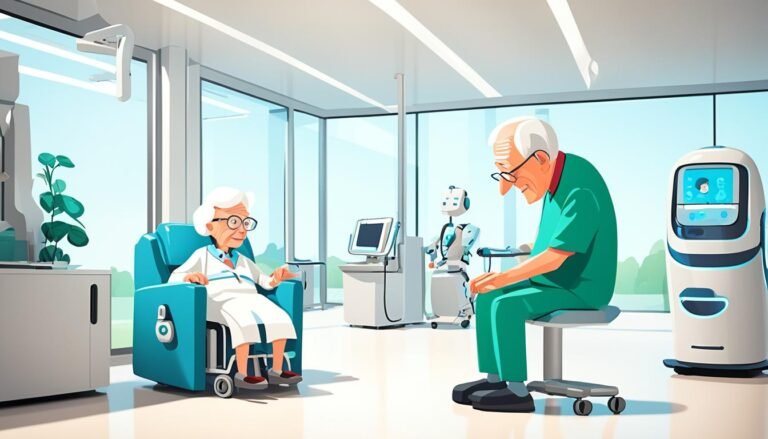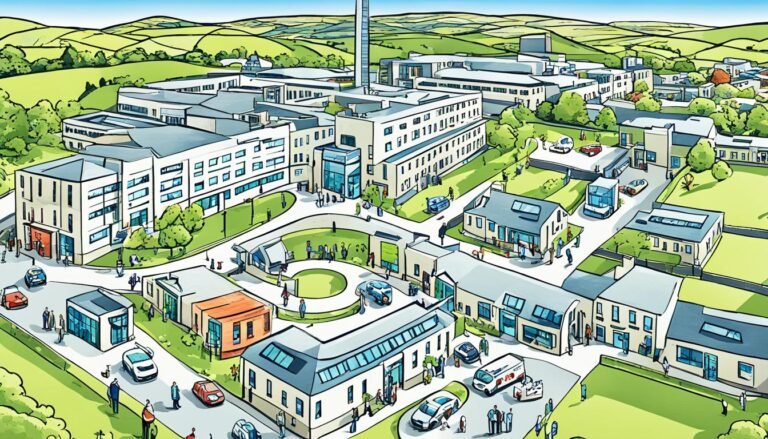Healthcare Workforce Development in Ireland: Addressing Shortages and Training Needs
Did you know the NHS has seen a huge 157% jump in healthcare workers leaving their jobs in the last ten years? This was mainly because of poor work-life balance. Ireland is facing a big shortage of healthcare workers, which could affect the quality and access to care for its people.
This issue isn’t just about numbers; Ireland’s Health Service Capacity Review from 2018 forecasts a massive 37% increase in primary care workforce needs by 2031. These numbers show how crucial it is to develop Ireland’s healthcare workforce. We need to tackle the shortage and prepare for future challenges by improving medical training programs.
Key Takeaways
- Work-life balance issues have led to a significant exodus of healthcare workers from the NHS, a trend also seen in Ireland.
- Ireland’s primary care workforce is projected to increase by 37% by 2031, highlighting the urgent need for strategic workforce planning.
- Enhanced medical professional training programs are vital to address current and future healthcare staffing needs in Ireland.
- Improving work conditions and offering competitive salaries can help attract and retain healthcare professionals.
- Reformative policies and international recruitment strategies are essential components of a comprehensive workforce development plan.
Understanding the Healthcare Workforce Shortage in Ireland
The healthcare workforce shortage in Ireland is complex. It’s caused by many things like demographic changes, economic issues, and social factors. These things affect how we manage healthcare workers and the healthcare system’s performance.
Factors Contributing to the Shortage
Several key factors lead to the shortage of healthcare professionals in Ireland:
- Demographic Changes: Ireland is seeing big changes in its population, like more older people. This means more need for healthcare services.
- Economic and Social Factors: Economic problems and social issues, like healthcare workers moving to other countries, make the shortage worse. Over half of new doctors plan to leave Ireland’s healthcare.
- International Recruitment: We depend a lot on hiring workers from other countries because we don’t have enough here. In high-income countries, there’s a 60% increase in migrant nurses and doctors over the past decade.
- Professor Cliona O’Farrelly from Trinity College Dublin says vaccines work well against the ‘Kraken’ variant. They help stop serious illnesses and deaths.
Impact on Healthcare Delivery
The shortage of healthcare workers really affects how healthcare is delivered in Ireland. Some big effects include:
- Extended Waiting Times: Places like University Hospital Limerick are too full, which hurts patient care. The Irish Nurses and Midwives Organisation says 44 patients are waiting for beds, adding up to 534 across all facilities.
- Increased Pressure on Existing Staff: Hospitals like St Vincent’s University Hospital and Mater Hospital have a lot of patients waiting. They have 38 and 31 patients waiting, respectively.
- Challenges in Recruitment: The Irish Medical Organisation says there are many empty consultant posts and it’s hard to hire junior doctors. This hurts how well services work and patient outcomes.
- Seasonal and Epidemic Pressures: With Covid-19, flu, RSV, and the ‘Kraken’ variant, things get even harder.
Looking at these issues, we can make better plans for managing healthcare workers. This could help ease the pressure and make healthcare better in Ireland.
Initiatives to Attract and Retain Healthcare Professionals in Ireland
Ireland is facing a big shortage of healthcare workers due to many reasons. To fix this, the country has started several projects to keep skilled professionals. These efforts aim to make sure Ireland has a strong healthcare team.
Increasing Educational Opportunities
To boost the healthcare talent pool, Ireland is focusing on nursing education. It’s taking in more students to meet the future need for nurses. By offering advanced courses and ongoing professional development, Ireland is preparing a skilled nursing workforce.
This move is crucial, as the World Health Organization predicts a shortage of 18 million skilled health workers by 2030.
Improving Working Conditions and Incentives
Keeping healthcare workers happy is key to solving the talent shortage. Many have left their jobs during the pandemic. Ireland is now offering better work-life balance, mental health support, and good pay to keep staff satisfied.
This approach matches the job demands-resources model of burnout. It shows how important it is to balance work with enough resources.
International Recruitment and Migration
Recruiting doctors from abroad is now vital due to the high demand for Irish healthcare staff. Ireland’s high educational standards and English language make its professionals in demand worldwide. This approach helps with local shortages but brings challenges like cultural fit and brain drain.
The European Commission expects a shortage of about 1 million health workers by 2020. This highlights the need for effective recruitment strategies.
Hospital groups and community healthcare projects are also part of the solution. They adapt to demographic changes and improve care. Ireland’s efforts in nursing education, better work conditions, and international recruitment are key to a strong healthcare system.
Addressing Specialty-Specific Shortages
Fixing gaps in primary care and specialized healthcare roles is key to Ireland’s healthcare strategy. Efforts are being made to strengthen primary care and improve training for healthcare specialties. This is to meet the changing needs of the population.
Focus on Primary Care
Improving primary care is a big part of Ireland’s healthcare plan. The Health Service Executive (HSE) wants more intern training posts for new doctors in primary care. The Medical Practitioners Act 2007 makes sure the HSE checks the number of specialist training posts needed every year. This keeps primary care a top priority.
A review by the Department of Health in 2014 showed the need for more doctors in primary care. So, many new programs have started to draw medical graduates to this area. For instance, “Securing the Future of Smaller Hospitals” says investing in smaller facilities is key for keeping primary care going across Ireland.
Specialized Healthcare Roles
Improving training for healthcare specialties is crucial to fix shortages. The National Doctors Training & Planning (NDTP) and Postgraduate Medical Training Bodies are working together. They make sure there are enough well-trained specialists to meet the country’s healthcare needs.
Data from the Doctors Integrated Management E-System (DIME) shows important details about the workforce. It includes the number of consultant posts, trainee intake, and the age of doctors. These numbers help plan better training for healthcare specialties.
The Health Service Executive’s 2019 report talked about the challenges faced by doctors not in training. It stressed the need for better training programs in specialized roles to keep these doctors engaged and in the workforce.
Investments and strategies for primary care and specialized healthcare roles are vital. They help ensure Ireland’s healthcare system can handle current and future needs.
Enhancing Training and Professional Development
Improving training and professional growth in healthcare is key to solving the shortage issue. By investing in healthcare skills development, places can make sure their staff can handle new patient needs. Working with schools is a big step in this process.
Upskilling Existing Healthcare Workforce
Keeping a steady flow of skilled workers needs ongoing education and training in healthcare. Using new upskilling programs, with both in-person and online learning, boosts the skills of current staff. For example, 23.2% of people prefer online training that happens at the same time, showing the need for flexible learning.
Studies, like one from 2008 in the Journal of Electromyography and Kinesiology, show that remote training works well.
Collaboration with Educational Institutions
Strong partnerships between healthcare groups and schools are vital for full professional development in healthcare. These partnerships help create tailored education and training in healthcare. This ensures that training meets the real needs of healthcare services. The NDTP National Medical Workforce Conference in November 2023 showed how these partnerships help with hiring and keeping staff.
Also, taking more students for CPD-SS for 2024-2025 shows a big effort to grow education in the field.
This teamwork approach not only fills current skill gaps but also ensures healthcare can keep up with future challenges.
Leveraging Technology and Telehealth
In recent years, telehealth in Ireland has changed how healthcare is delivered. Digital health platforms and remote monitoring systems have made healthcare better, especially for those in rural areas. Now, there’s a big need for healthcare technology training and support. This ensures healthcare workers can use these new tools well.
Role of Technology in Optimizing Healthcare Delivery
Telehealth has changed how we manage patient information with Electronic Health Records (EHR). This tech gives doctors easy access to patient data. It helps keep care continuous and cuts down on mistakes.
AI and automation make diagnostics more precise and treatment plans more tailored. This shows why healthcare workers need good training on these new tools.
Training and Support for Technology Adoption
For telehealth to work well in Ireland, healthcare workers need strong training and support. They must learn how to manage IT systems and data well. Programs for ongoing learning are key to keep them up-to-date with new tech.
It’s also vital to create a supportive space. Here, healthcare workers feel good about using new tech. This is key for using telehealth for the long term.
Investing in the Future Healthcare Workforce
The Irish government is investing a lot to get more healthcare workers. They want to make sure there are enough healthcare professionals in the future. They’re focusing on young people and improving healthcare education to meet the needs of tomorrow.
Encouraging Young Talent
They’re working hard to get young people interested in healthcare jobs. They’re offering education programs for schools and universities to show the many jobs in healthcare. They’re also starting campaigns and scholarships to make healthcare education easier to get into.
The Ministry of Health is working with schools to help students move from studying to working in healthcare. They have mentorship and internship programs. These give young people the skills they need for a career in healthcare.
Strengthening Healthcare Education Infrastructure
They need to make healthcare education stronger to keep up with the demand. This means making medical schools and training places bigger to take in more students. They want to increase the number of GP trainees to fix the expected shortage of up to 1380 GPs by 2025.
- Enhancing the curriculum to include modern medical practices and technologies.
- Establishing state-of-the-art training centers.
- Increasing data collection to improve insights into various aspects of GP care such as visitation rates.
By focusing on young people and improving education, Ireland is building a strong healthcare workforce. These steps will help make sure there are enough healthcare professionals in the future. They’ll be ready to meet the health needs of the country.
Healthcare Workforce Development in Ireland
In Ireland, planning the healthcare workforce well means knowing about key reports and studies. The Medical Workforce Analysis Report gives an annual look at the medical workforce. It shows big changes over the years. The Retention of Training Doctors in the Irish Health System study looks at how many trainee doctors stay or leave.
The Annual Retention Report tracks how doctors move in and out of the country. *Specialty Specific Reviews* offer important data and forecasts for different medical areas. General Practice Workforce Planning Reports show what the future needs for general practice will be.
Reports show the need for planning up to 2028 for medical consultants and specialists in Ireland. They compare Ireland’s medical workforce with other countries. This gives insights into what works well and what doesn’t.
Good *healthcare workforce development* means understanding now and planning for the future. Ireland’s healthcare budget for 2023 is a big €23.4 billion, up from 2022. This shows a big focus on healthcare infrastructure and the workforce. It shows that having a strong healthcare workforce plan is key to tackling healthcare challenges now and in the future.
New ways in *healthcare human resources management* are vital, backed by detailed data analysis and reports. Ireland is increasing the number of nurses and dentists and hiring more caring staff. This shows how careful planning can fix shortages and make healthcare better.
Collaboration with International Medical Bodies
Working together with doctors from around the world is key to improving Ireland’s healthcare. By joining forces, Ireland gets to use global knowledge and resources. This helps tackle healthcare challenges at home more effectively.
For example, Irish and international medical teams have teamed up to help with the aging population. With Ireland’s population growing, these partnerships help manage the health system’s load. They also support Ireland in making its health governance stronger, like with the HSE Governance Act in 2019.
Healthcare partnerships help Ireland change and improve its healthcare system, as seen in the Sláintecare plan. This plan aims to give everyone access to top-quality health services. Through working together, Ireland learns from the best and improves how services are delivered, like the ‘hub and spoke’ model introduced in 2019.
These partnerships also help Ireland get ready for health crises. For instance, a team worked with the Department of Health to check how well the health system could handle public health issues after COVID-19. This helps make policy decisions that make the health system stronger and more able to handle challenges.
Overall, working with medical groups from other countries is crucial for Ireland’s healthcare. It offers chances for doctors to grow professionally and adapt to changes in healthcare due to population shifts and reforms.
The Role of Government Policies in Workforce Development
Government policies are key to improving Ireland’s healthcare workforce. They affect how we hire, keep, and grow healthcare workers. By supporting staff and building up healthcare systems, the government helps fix workforce shortages and boost health outcomes.
In 2018, a big discussion paper was started after the Crowe Howarth report. This report looked at public health systems in nine countries, including Australia and Canada. It also talked about the problem of ‘trapped talent’ in Ireland’s public health sector.
Policy Initiatives and Impacts
The government has launched policies to tackle these issues. For example, Wales’ model for a multidisciplinary public health workforce is being studied. It includes updated laws, working with local governments, and a detailed system for registering public health workers.
Experts say creating a strong public health workforce needs careful planning and clear rules. The Department of Health is working with the World Health Organization to improve public health services. They’re looking at how to better support the workforce.
The Public Health Reform Expert Advisory Group is also working on a report about the COVID-19 pandemic. They aim to make future health responses stronger. This will help improve public health functions.
There are efforts to change how health and social care professionals are regulated. This includes looking at regulatory bodies, practice standards, and the Professional Standards Authority. A working group is looking into which new healthcare jobs should be officially regulated.
The UK’s Modernising Scientific Careers (MSC) project started in 2009. It aims to improve the careers of healthcare science workers. This shows how government policies can help the healthcare workforce, benefiting patients, employers, and staff.
In summary, the government’s role in healthcare workforce development is crucial. Through strategic policies, the government is working to build a strong healthcare system for the future.
Challenges in Implementing Workforce Development Strategies
Implementing healthcare workforce strategies in Ireland is tough. It faces big challenges like managing resources and following rules. Healthcare systems try to meet service demands with limited resources. They must use resources well and follow the rules to make strategies work.
Resource Allocation
The healthcare workforce in Ireland is under a lot of pressure. Demand often exceeds supply. Making smart choices about where to use money, people, and technology is key.
On September 8th, 2023, leaders talked about how to improve. They discussed keeping staff, cutting costs, and starting apprenticeships. They said we need a big-picture approach, not just focusing on individual places.
Using data for focused actions and investing in new roles is important for a strong workforce.
Regulatory Hurdles
Dealing with rules is a big part of healthcare strategy. Rules about training, staff, and services can be strict. They must match workforce development plans.
Discussions showed the need for better hiring and keeping staff, and using staff well. The COVID-19 pandemic showed how important staff well-being is. It highlighted the need for changes in rules and work conditions.
This means working together to follow rules and create a good work environment. It’s important for growth and sustainability in healthcare.
Source Links
- Implications for health system reform, workforce recovery and rebuilding in the context of the Great Recession and COVID-19: a case study of workforce trends in Ireland 2008–2021
- Clinician-centred approach to healthcare shortages
- Ireland’s Healthcare Workforce: Challenges and Solutions
- Doctor Retention in Ireland – What It May Mean for the Global Health Workforce Reform Agenda Comment on "Doctor Retention: A Cross-sectional Study of How Ireland Has Been Losing the Battle"
- Ireland facing ‘medical workforce shortage’ – IMO
- Retaining Healthcare Workers: A Systematic Review of Strategies for Sustaining Power in the Workplace
- 7 Strategies for Improving Healthcare Workforce Retention
- Figure 2.12 Gender of Consultants matched to posts
- Doctor Retention in Ireland – Where Are the Failings That Prolong the Problem? Comment on "Doctor Retention: A Cross-sectional Study of How Ireland Has Been Losing the Battle"
- Barriers and strategies for primary health care workforce development: synthesis of evidence
- National Doctors Training and Planning – HSE.ie
- Addressing the Healthcare Workforce Shortage in Ireland: Strategies and Solutions
- The Changing Landscape of Healthcare Employment in Ireland
- 27411 Planning Workforce Guide (Edits)
- EUPHA Section – Health and care workforce research Newsletter
- The Future of Healthcare Workforce Development and Management
- Workforce Planning – HSE.ie
- Ireland – Healthcare
- Minister for Health highlights increase in health workforce – Health Manager
- A novel approach to utilizing the essential public health functions in Ireland’s health system recovery and reform
- Discussion paper examines potential for a multi-disciplinary public health workforce in Ireland – Health Manager
- Workforce development professional regulation | Department of Health
- Ireland – Country Reports | Ireland offers a best-practice example of workforce development for the 21st century








